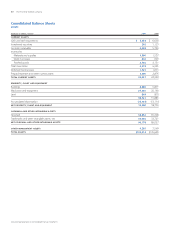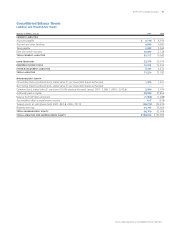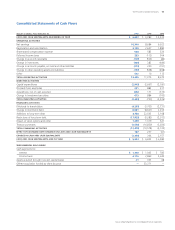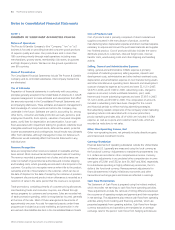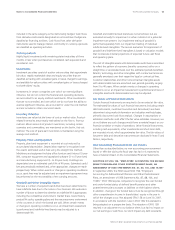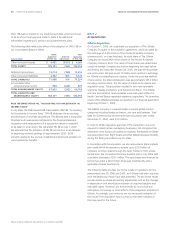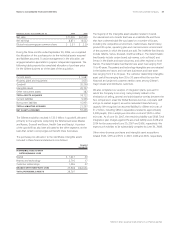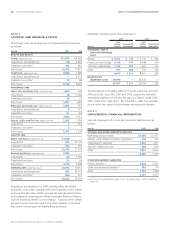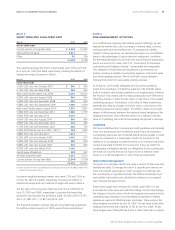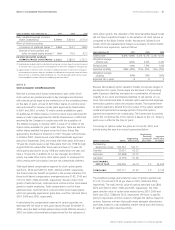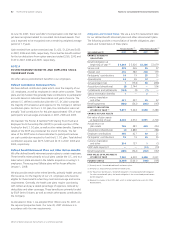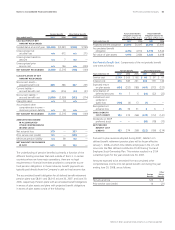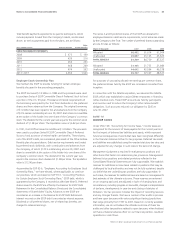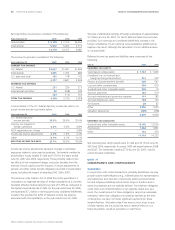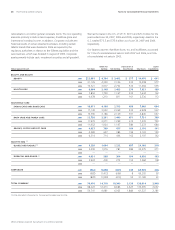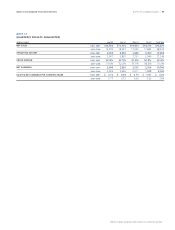Proctor and Gamble 2007 Annual Report Download - page 62
Download and view the complete annual report
Please find page 62 of the 2007 Proctor and Gamble annual report below. You can navigate through the pages in the report by either clicking on the pages listed below, or by using the keyword search tool below to find specific information within the annual report.
Millions of dollars except per share amounts or as otherwise specied.
Notes to Consolidated Financial Statements
The Procter & Gamble Company
60
on earnings from hedge ineffectiveness. For cash ow hedges, the
effective portion of the changes in fair value of the hedging instrument is
reported in other comprehensive income (OCI) and reclassied into
interest expense over the life of the underlying debt. The ineffective
portion, which is not material for any year presented, is immediately
recognized in earnings. The fair value of these cash ow hedging
instruments was an asset of $53 and $225 at June 30, 2007 and
2006, respectively. During the next 12 months, $33 of the June 30,
2007 OCI balance will be reclassied to earnings consistent with the
timing of the underlying hedged transactions.
We manufacture and sell our products in a number of countries
throughout the world and, as a result, are exposed to movements in
foreign currency exchange rates. The purpose of our foreign currency
hedging program is to reduce the risk caused by short-term changes
in exchange rates.
To manage this exchange rate risk, we primarily utilize forward contracts
and options with maturities of less than 18 months and currency swaps
with maturities up to ve years. These instruments are intended to
offset the effect of exchange rate uctuations on forecasted sales,
inventory purchases, intercompany royalties and intercompany loans
denominated in foreign currencies and are therefore accounted for as
cash ow hedges. The fair value of these instruments at June 30, 2007
and 2006, was $34 and $25 in assets and $2 and $58 in liabilities,
respectively. The effective portion of the changes in fair value of these
instruments is reported in OCI and reclassied into earnings in the
same nancial statement line item and in the same period or periods
during which the related hedged transactions affect earnings.
The ineffective portion, which is not material for any year presented,
is immediately recognized in earnings.
Certain instruments used to manage foreign exchange exposure of
intercompany nancing transactions, income from international
operations and other balance sheet items subject to revaluation do
not meet the requirements for hedge accounting treatment. In these
cases, the change in value of the instruments is designed to offset the
foreign currency impact of the related exposure. The fair value of these
instruments at June 30, 2007 and 2006, was $110 and $17 in assets
and $78 and $19 in liabilities, respectively. The change in value of
these instruments is immediately recognized in earnings. The net impact
of such instruments, included in selling, general and administrative
expense, was $56, $87 and $18 of gains in 2007, 2006 and 2005,
respectively, which substantially offset foreign currency transaction
and translation losses of the exposures being hedged.
We hedge certain net investment positions in major foreign subsidiaries.
To accomplish this, we either borrow directly in foreign currency and
designate all or a portion of foreign currency debt as a hedge of the
applicable net investment position or enter into foreign currency swaps
that are designated as hedges of our related foreign net investments.
Under SFAS 133, changes in the fair value of these instruments are
immediately recognized in OCI to offset the change in the value of
the net investment being hedged. Currency effects of these hedges
reected in OCI were after-tax losses of $835 and $786 in 2007 and
2006, respectively, and a $135 after-tax gain in 2005. Accumulated
net balances were $2,072 and $1,237 after-tax losses as of June 30,
2007 and 2006, respectively.
Certain raw materials utilized in our products or production processes
are subject to price volatility caused by weather, supply conditions,
political and economic variables and other unpredictable factors.
To manage the volatility related to anticipated purchases of certain of
these materials, we use futures and options with maturities generally
less than one year and swap contracts with maturities up to ve years.
These market instruments generally are designated as cash ow hedges
under SFAS 133. The effective portion of the changes in fair value for
these instruments is reported in OCI and reclassied into earnings in the
same nancial statement line item and in the same period or periods
during which the hedged transactions affect earnings. The ineffective
portion, which is not material for any year presented, is immediately
recognized in earnings. The fair value of these cash ow hedging
instruments was an asset of $70 and $32 at June 30, 2007 and 2006,
respectively. During the next 12 months, $14 of the June 30, 2007
OCI balance will be reclassied to earnings consistent with the timing
of the underlying hedged transactions.
The Company purchases limited discretionary insurance to cover
catastrophic property damage, business interruption, and liability risk
of loss exposures. Deductibles and loss sharing will likely increase over
time, recognizing the Company’s ability to cost-effectively fund losses
from internal cash ow generation and access to capital markets.
NOTE 7
Net earnings less preferred dividends (net of related tax benets) are
divided by the weighted average number of common shares outstanding
during the year to calculate basic net earnings per common share.
Diluted net earnings per common share are calculated to give effect to
stock options and other stock-based awards (see Note 8) and assume
conversion of preferred stock (see Note 9).
Net earnings and common shares used to calculate basic and diluted
net earnings per share were as follows:
Years ended June 30 2006 2005
$8,684 $6,923
Preferred dividends,
net of tax benefit (148) (136)
8,536 6,787
Preferred dividends,
net of tax benefit 148 136
Preferred dividend impact on
funding of ESOP
—
(1)
8,684 6,922


